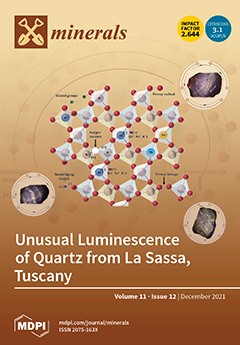Ferrotorryweiserite, Rh
5Fe
10S
16, occurs as small grains (≤20 µm) among droplet-like inclusions (up to 50 μm in diameter) of platinum-group minerals (PGM), in association with oberthürite or Rh-bearing pentlandite, laurite, and a Pt-Pd-Fe alloy (likely isoferroplatinum and Fe-Pd-enriched platinum), hosted by placer grains of Os-Ir alloy (≤0.5 mm) in the River Ko deposit. The latter is a part of the Sisim placer zone, which is likely derived from ultramafic units of the Lysanskiy layered complex, southern Krasnoyarskiy kray, Russia. The mineral is opaque, gray to brownish gray in reflected light, very weakly bireflectant, not pleochroic to weakly pleochroic (grayish to light brown tints), and weakly anisotropic. The calculated density is 5.93 g·cm
–3. Mean results (and ranges) of four WDS analyses are: Ir 18.68 (15.55–21.96), Rh 18.34 (16.32–20.32), Pt 0.64 (0.19–1.14)
, Ru 0.03 (0.00–0.13), Os 0.07 (0.02–0.17), Fe 14.14 (13.63–14.64), Ni 13.63 (12.58–14.66), Cu 4.97 (3.42–6.41), Co 0.09 (0.07–0.11), S 29.06 (28.48–29.44), and total 99.66 wt.%. They correspond to the following formula calculated for a total of 31 atoms per formula unit: (Rh
3.16Ir
1.72Pt
0.06Ru
0.01Os
0.01)
Σ4.95(Fe
4.48Ni
4.11Cu
1.38Co
0.03)
Σ10.00S
16.05. The results of synchrotron micro-Laue diffraction studies indicate that ferrotorryweiserite is trigonal; its probable space group is
Rm (#166) based on its Ni-analog, torryweiserite. The unit-cell parameters refined from 177 reflections are
a = 7.069 (2) Å,
c = 34.286 (11) Å,
V = 1484 (1) Å
3, and Z = 3. The
c:
a ratio is 4.8502. The strongest eight peaks in the X-ray diffraction pattern derived from results of micro-Laue diffraction study [
d in Å(
hkil)(I)] are 2.7950 (20
5) (100); 5.7143 (0006) (60); 1.7671 (22
0) (44.4); 3.0486 (20
1) (39.4); 5.7650 (10
2) (38.6); 2.5956 (20
7) (37.8); 3.0058 (11
6) (36.5); and 1.5029 (4
12) (35.3). Ferrotorryweiserite and the associated PGM crystallized from microvolumes of residual melt at late stages of crystallization of grains of Os- and Ir-dominant alloys occurred in lode zones of chromitites of the Lysanskiy layered complex. In a particular case, the residual melt is disposed peripherally around a core containing a disequilibrium association of magnesian olivine (Fo
72.9–75.6) and albite (Ab
81.6–86.4), with the development of skeletal crystals of titaniferous augite: Wo
40.8–43.2En
26.5–29.3Fs
20.3–22.6Aeg
6.9–9.5 (2.82–3.12 wt.% TiO
2). Ferrotorryweiserite represents the Fe-dominant analog of torryweiserite. We also report occurrences of ferrotorryweiserite in the Marathon deposit, Coldwell Complex, Ontario, Canada, and infer the existence of the torryweiserite–ferrotorryweiserite solid solution in other deposits and complexes.
Full article





